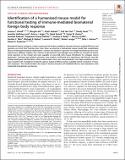Identification of a humanized mouse model for functional testing of immune-mediated biomaterial foreign body response
Author(s)
Doloff, Joshua C; Ma, Minglin; Sadraei, Atieh; Tam, Hok Hei; Farah, Shady; Hollister-Lock, Jennifer; Vegas, Arturo J; Veiseh, Omid; Quiroz, Victor M; Rakoski, Amanda; Aresta-DaSilva, Stephanie; Bader, Andrew R; Griffin, Marissa; Weir, Gordon C; Brehm, Michael A; Shultz, Leonard D; Langer, Robert; Greiner, Dale L; Anderson, Daniel G; ... Show more Show less
DownloadPublished version (1.376Mb)
Publisher with Creative Commons License
Publisher with Creative Commons License
Creative Commons Attribution
Terms of use
Metadata
Show full item recordAbstract
Biomedical devices comprise a major component of modern medicine, however immune-mediated fibrosis and rejection can limit their function over time. Here, we describe a humanized mouse model that recapitulates fibrosis following biomaterial implantation. Cellular and cytokine responses to multiple biomaterials were evaluated across different implant sites. Human innate immune macrophages were verified as essential to biomaterial rejection in this model and were capable of cross-talk with mouse fibroblasts for collagen matrix deposition. Cytokine and cytokine receptor array analysis confirmed core signaling in the fibrotic cascade. Foreign body giant cell formation, often unobserved in mice, was also prominent. Last, high-resolution microscopy coupled with multiplexed antibody capture digital profiling analysis supplied spatial resolution of rejection responses. This model enables the study of human immune cell–mediated fibrosis and interactions with implanted biomaterials and devices.
Date issued
2023-06-16Department
Massachusetts Institute of Technology. Department of Chemical EngineeringJournal
Science Advances
Publisher
American Association for the Advancement of Science
Citation
Joshua C. Doloff et al. ,Identification of a humanized mouse model for functional testing of immune-mediated biomaterial foreign body response.Sci. Adv.9,eade9488(2023).
Version: Final published version